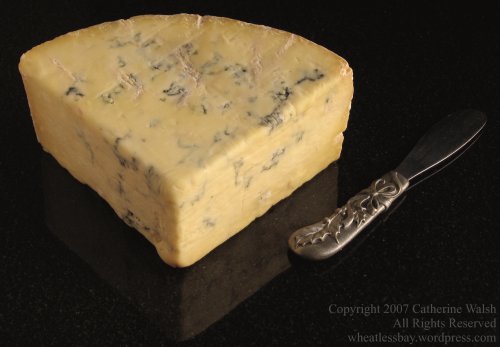Instead of a globe-trotting recipe this week, I had wanted to write a simple guide to buying and serving good cheese. Cheese is a simple and powerful link with the past. Rich and poor alike, Europeans ate cheese for hundreds, even thousands of years. But cheese, like wine, is a very complicated matter that requires time, study, and lots of good samples; frankly, anything meaningful is beyond the scope of a short article. So, because I believe that in complicated circumstances simple examples can be best, I’m just going to describe the cheeses that I’m serving over the holidays, with some pairings. I’ll follow that with a few thoughts on buying and serving cheese. If that’s interesting to you, terrific. If that’s not, well then Merry Christmas and see you next year!
My Cheese Selection for the Holidays
By category and with pairings, here’s what I’ve got:
A Blue-veined: English stilton is a semi-firm, full-flavoured, crumbly blue, typically not as salty as Danish nor as creamy as young gorgonzola. Unlike French roquefort, there is no rye bread involved in the production of stilton, so it’s safe for coeliacs. Like most blues, it works well with rice cakes (yes, those big dry disks), dried dates (stone-in are more moist and flavourful than the pitted kind), and a big fruity tannic red wine wine, or fortified wines like sherry or port. Seasonally-speaking, it’s nice against cranberry jelly.
A Crowd-pleaser: Aged Dutch gouda (as opposed to the young, semi-firm cheese) is a hard cheese that’s sweet and caramel-like in flavour and everybody loves it. I like it with fig compote and any kind of toasted bread or cracker. I think it’s meant for beer, but if you don’t have any, try a dry apple cider.
A Soft and Downy: I do have a disk of camembert fait en Normandie ripening in my fridge, although it is neither name-controlled nor made from raw-milk (more on that below, if you’re interested). I buy what I can find, and even though it’s a factory cheese, as a whole plump wheel ripened to within a few days of its shelf-life it is not half-bad: garlicky and mushroomy. Soft downy cheeses with high cream content are great with sparkling wine and fresh fruit.
Two Firm and Rich: I have both an aged Swiss gruyere, which I find to be beefy and salty, and an aged English cheddar, which is sharp and toffee-like. Swiss-made cheeses are good bets: the Swiss, and this will surprise no one who’s visited their country, hold their cheesesmakers to very high standards, and they mostly make hard, hardy cheeses, the sort that travel well. The same can be said for two-year-old cheddars, although mine came from just up the road. I think that well-aged cheddar is nice with corn cakes (yes, those big dry disks) and lightly smoked Polish sausage. I like Swiss gruyere with cured meat, too, but the dry-cured kind like bundnerfleisch. Both cheeses can stand up to big whites or reds.
A Curiosity: I blindly picked-up an AOC ossau-iraty from the French Pyrenees, because you can learn something new every day. It’s a hard sheep’s milk cheese, supposedly a Basque recipe thousands of years old. It looks promising, and I think I’ll serve it with olives, serrano ham and a rioja.
But the Little Stinker: is thus far an unrequited love, as I am still trying to find a barn-yardy, washed rind cheese for this critical category. Sadly, all the reblochon in town is fake, the epoisse dried and sunken, and the Alsatian muenster oozing and slimy. In the UK this category is the toughest to fulfill (while under the USDA’s pasteurization laws it is nigh-impossible). But I still have a few days…
General Notes on Cheese
Thumbnail sketches are necessarily incomplete with such a complicated subject, but I do shop for, store, and serve cheese with a few broad biases:
- Raw milk cheese is usually more flavourful than cheese made with pasteurized milk. The USDA bans European imports of raw-milk cheeses aged less than sixty days to the US.
- Aged cheese is usually more flavourful than young cheese.
- Soft, washed-rind cheeses (the rind looks moist and there is no fuzziness) are usually the most aromatic.
- Soft cheeses should look plump in their cases. If they are whole, I can ripen them up until near their best-before dates for maximum flavour.
- Name-controlled European cheese (AOC, DOC, DO, or PDO are the abbreviations you will see) is usually a best bet, though not always. The control is for region, milk, and production, but does not guarantee an interesting cheese, or proper handling. But the French, Swiss, Spanish and Italians do feel they having something worth protecting, and they are right.
- At home, I keep cheese loosely wrapped in a closed (but not perfectly sealed box) in the refrigerator. Cheese needs to breathe without drying out.
- I present cheeses in big pieces that have come to room temperature in their wrappers for the hour before serving.
- Each cheese should get its own knife, and ideally have some room.
- I pair cheeses with crackers, olives, dried fruit, nuts, fresh fruit, chutneys, and compotes. If I had good bread I’d certainly use it.
- I pair cheeses with reds, whites, ports, sherries, sparklers, and ciders. If I had good beer I’d certainly use it.
- A safe way to pair is to match cheese to the foods and beverages that are produced nearby (eg. brie with champagne, parmigiano with chianti, queso de zuheros with almonds).











